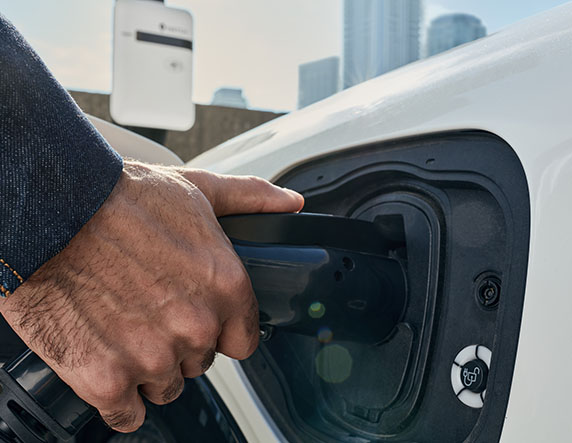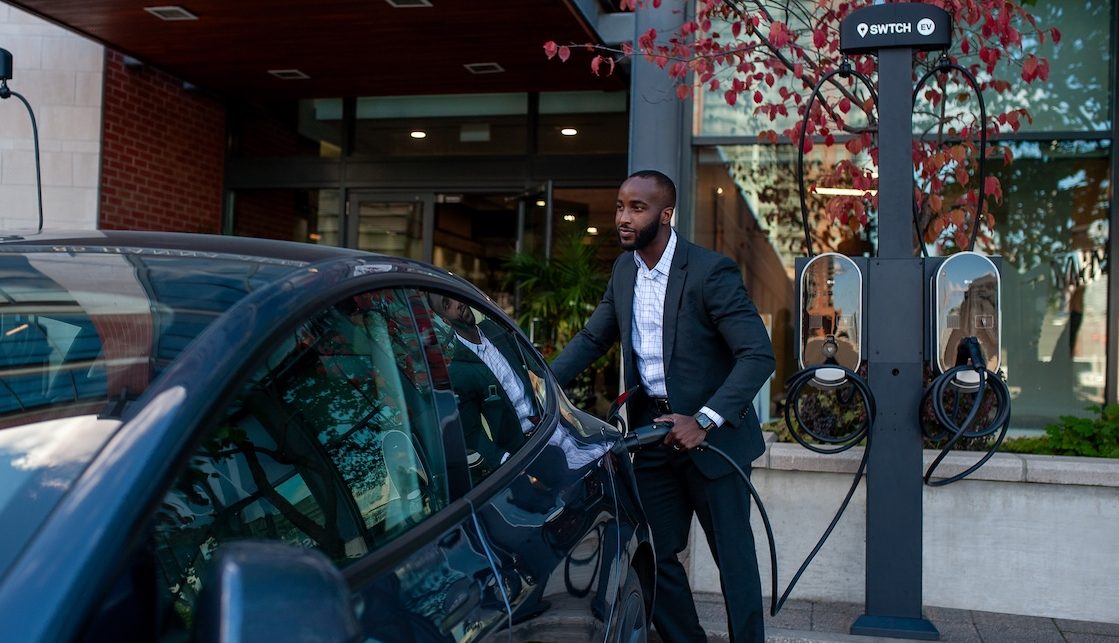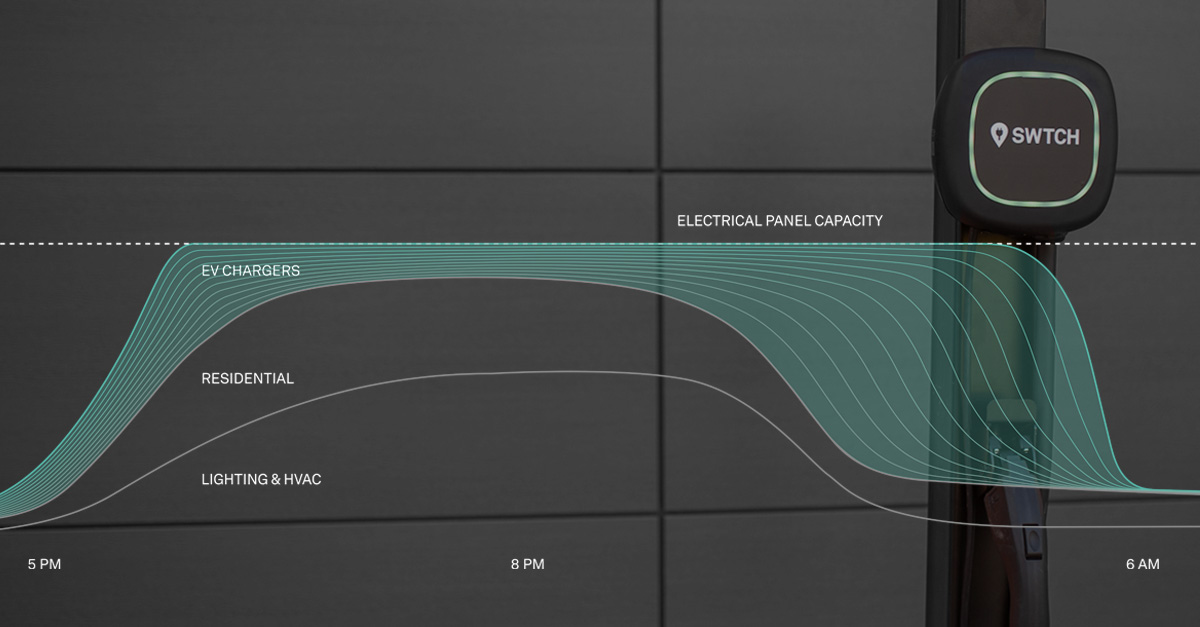How V2X, V2G, and V2B Technologies revolutionize EV charging and our energy systems
Vehicle-to-grid (V2G), vehicle-to-building (V2B) and vehicle-to-everything (V2X) describe technology that allows for electric vehicles to use charging connections to not just take in electricity, but also to send it back.
With this ability, electric vehicle chargers are no longer just used to fill up batteries and keep electric cars on the road. Instead, they’re turning into interfaces for an intelligent energy system that will help buildings moderate their electricity consumption, keep the lights on when the power’s out, and help the grid out when demand exceeds supply.
Here’s what you need to know about how V2X technology works, what it means for vehicles and drivers, and why it’s set to be such an important element of our clean energy future.
What is V2X Technology?
When an electric vehicle is connected to a V2X-compatible charger, V2X technology allows for electricity to flow from that vehicle, through the charger, and into the onsite electrical infrastructure.
From there, the electricity can be delivered wherever it is needed. This could be to systems within the building itself, such as in cases of a power outage. It could also be to the grid in situations where renewable energy generation is lower than expected, such as on cloudy days or days without much wind. It could also be during periods of high demand, such as during heat waves or cold snaps, when cooling and heating systems are drawing more power.
There are many different types of arrangements underneath the umbrella of “V2X.” Here are some of the most important.
V2B – Vehicle-to-building
Vehicle-to-building refers to technologies and processes that allow energy stored by a vehicle’s battery to be sent back to a building.
In the case of detached or semi-detached homes, this can be used to power appliances, lighting, WiFi, and other essentials when the power is out.
It could also be used even when the power is not out, allowing an EV owner to draw on stored energy in their car at times of day when electricity sold by the grid is most expensive and replenishing the battery overnight when the cost is lower.
And for individuals who elect to live off-grid, V2B could be an essential technology for making up for shortfalls in rooftop solar or other on-premises energy generation when required.
There is also an opportunity to make use of this technology in non-residential spaces, such as commercial properties, healthcare facilities, or small towns, though the demands of such places are generally much higher, and would likely require a large number of connected EVs to make a real dent in ongoing demand.
V2G – Vehicle–to-grid
Vehicle-to-grid is probably the most commonly discussed of the various applications under the V2X umbrella. With V2G, the energy stored in an EV’s battery is sent back to the grid in times of high demand. This can help the grid stabilize, keep overall costs low, and generally allow for energy to be used more intelligently and efficiently, somewhat reducing the need for more energy capacity overall.
This is the application we’ll discuss the most in this article, and is generally the most impactful (and we’d say exciting) opportunity presented by V2X.
Read: SWTCH LAUNCHES AN INNOVATIVE V2G & E-MOBILITY PILOT
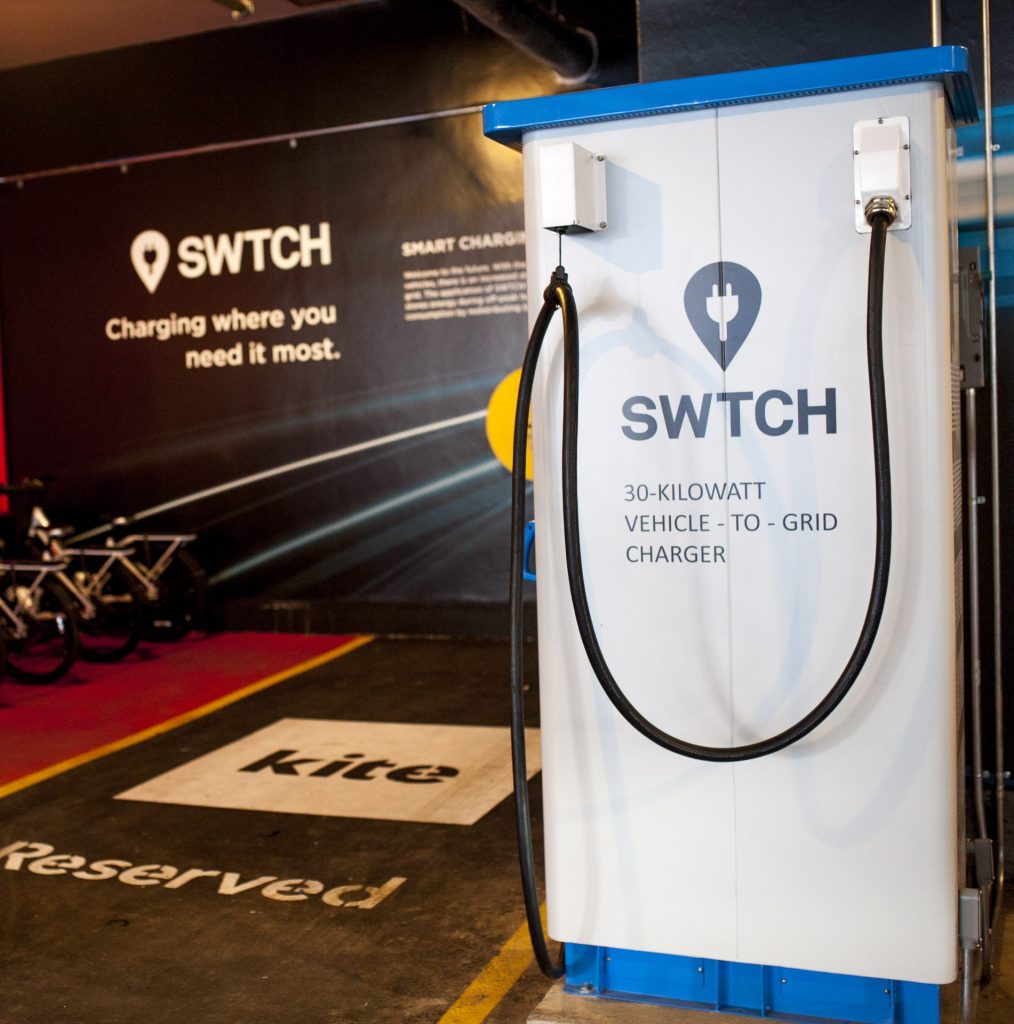
V2L – Vehicle-to-load
Vehicle-to-load is a really interesting, albeit simpler, way to access the energy stored within an EV’s battery. With V2L, a vehicle is outfitted with outlets that allow devices or appliances to be plugged into the vehicle just like they would be plugged in at home, and powered or charged up accordingly.
This doesn’t really require the same level of smarts to pull off as something like V2G, where there’s a complex interaction between grids, buildings, chargers, and EVs to deliver energy where it needs to go when it is most needed, but it’s certainly useful!
Expect to see V2L offer some interesting new possibilities for activities like car camping, or for workers who want to bring particular tools with them for offsite projects or remote work.
How does V2X work?
The vehicle-to-everything process requires that a charger and a vehicle be able to switch between, essentially, three modes:
- Charging, where electricity is sent by the grid, through the charger, and to the vehicle’s battery
- Discharging, where electricity is sent by a vehicle’s battery back through to the building or grid
- Idle, where a car is connected to the charger but is neither drawing power to charge itself nor discharging power to participate in V2X programs
Here’s a look at some critical technologies required to make this kind of process work.
Bidirectional chargers & power inverters
The core technology for V2X, arguably, is the bidirectional charger. This is the specialized component that enables two-way flow of electricity (also known as bidirectional charging).
Another core component is the power inverter. With normal EV charging, the inverter is tasked with converting an AC current to DC, which is what is used by the EV battery. But with bidirectional charging, the DC power in the EV instead needs to be converted back to AC for delivery back to the building or the grid.
Communication networks
In order for a vehicle and a charger to participate in V2X energy transfers, there must be a communication network in place to allow them to communicate with the building, the utility, and the grid. This is how info about energy demand and availability, prices for energy sold back to the grid, and more would be communicated. When a building or a utility puts out a call for chargers and their connected EVs to participate in a V2X activation, the call would go out on this network.
Energy management systems
An energy management system (EMS) is the software that controls an EV chargers and allows its participation in V2X programs. It will monitor data from the building and/or the grid to understand when there is a need for energy to be sent back from the car, and it will also monitor data from the car to understand its current state of charge, the owner’s preferences for how their vehicle can participate in a V2X program, etc.
See how SWTCH enables smart EV charging in all sorts of environments
The benefits of V2X technology for the grid and other energy systems
There’s a lot that V2X can do to improve the way we use and manage our energy. Generally, the themes are around greater flexibility, greater resilience, and even saving on costs. This is both for day-to-day energy consumption and in a larger, broader context related to government investment in energy production.
Here’s a look at some of the biggest benefits V2X can offer.
V2X improves grid stability
Daily electricity consumption and demand is not evenly distributed. Generally, consumption is relatively low during the day, rises in the evenings when people return home, cook their meals, cool or heat their homes, and then falls pretty dramatically overnight.
Being able to work to balance out these peaks and troughs is called “demand response,” and it’s one of the more powerful ways that EVs and EV chargers can use V2X tech to society’s benefit.
When demand is high and there’s potential for strain on the system, all the EVs that are plugged in and participating in V2X demand response programs can essentially act like a distributed power reserve to deliver energy where it is needed. And then, when demand falls off overnight, they can recharge their batteries so that drivers are all ready to go again the next morning.
V2X helps solve a key hurdle for renewable energy
Another big benefit of V2X technology is that it is a smart and affordable solution to help address a key challenge of renewable energy sources like solar and wind: inconsistency.
Just about everywhere on Earth has days where the clouds don’t let much sun shine through to solar installations or days where there isn’t sufficient wind to propel a wind turbine. For places that rely on these energy sources—and there are more of them every year—this can cause a significant challenge. People don’t just stop needing electricity when there’s less sun.
The solution, then, is energy storage, but it can be an expensive proposition for governments to install sufficient battery storage to make up for the shortfall on cloudy or windless days.
With V2X, however, it’s possible to tap into the batteries of the EVs a growing number of people use every day and offset dips in renewable generation that way. It’s a smart solution to an important problem, and something we’re sure to see take on huge importance in the future.
V2X can help a building operate key systems during a blackout
Sometimes, extreme weather can come with blackouts, and the longer a blackout continues, the bigger the potential for problems faced by tenants and property owners alike.
With V2X, there’s potential to draw on the energy storage of electric vehicles to keep some systems running while the grid is down. For single-family, detached homes, a sufficiently charged EV could keep the whole house running for multiple days. For multifamily properties, commercial properties, or other environments with greater energy demands, you likely won’t be able to power everything for multiple days, but there’s certainly potential for keeping some key systems online for the duration of a power outage.
Particularly in remote areas where energy security is more of a challenge, this type of opportunity can be hugely beneficial, with substantial impacts on everything from health to food security to basic comfort.
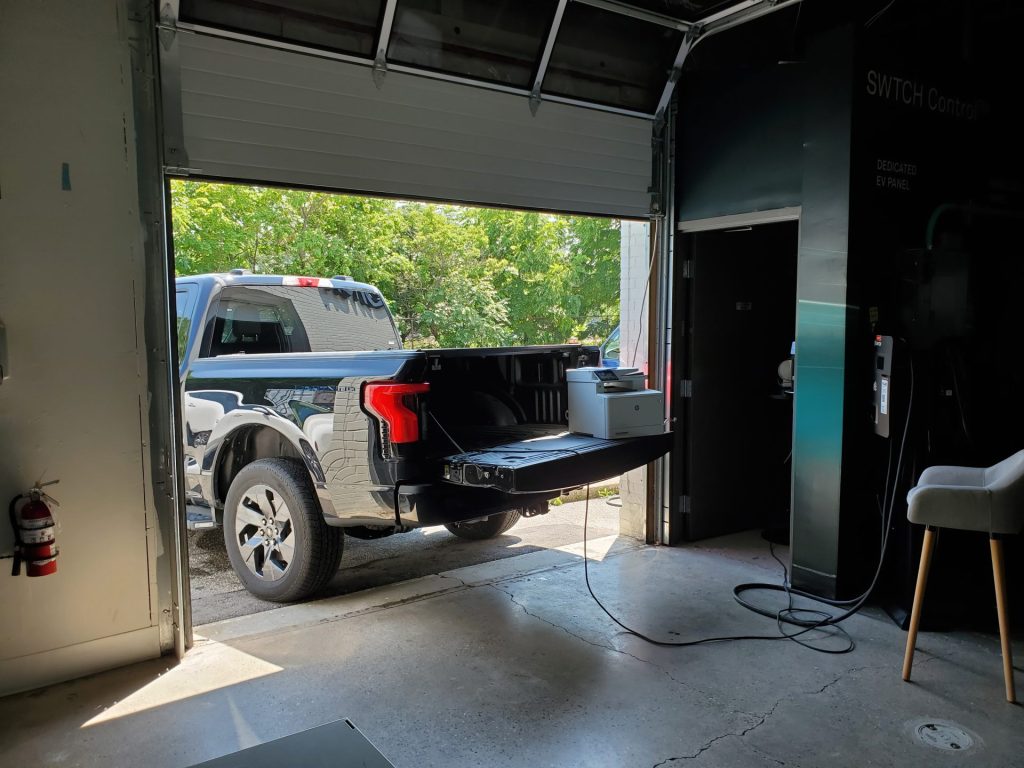
Regulations, incentives, and participation: Making V2X work for everyone
For V2X, and particularly V2G, to work well, several different stakeholders need to be involved in planning, coordinating, and participating in the process.
From the outset, there must be clear regulatory frameworks put in place by governments, as well as mechanisms put in place by utilities to define who can participate, how that participation will integrate with the overall grid, and whether and how much participants are to be compensated for their contributions to the grid.
There must also be technologies to support these types of programs. Smart chargers, EV charging software that allows for these chargers to participate in V2X programs, and vehicles themselves allowing for discharge back through charging stations are all essential. Standards like the Open Charge Point Protocol (OCPP) are working to define how these connections should work to enable bidirectional charging to work properly, but we’re still in the early stages of actual deployment.
Why should EV owners participate in V2X programs?
There are clear benefits for governments and utilities in having V2G programs; it lets them keep power systems working well in situations where the grid is under stress, and without the same level of direct investment required on their part as compared with creating new utility-scale power generation or storage facilities. In fact, research has found that even low participation in such programs could handle short-term grid storage and stability demands by 2030.
But why should drivers participate, given that this technology is dependent on work being done by their vehicles to send power back when the grid comes calling?
First, it’s important to note that, as of today, research has shown there is likely no negative impact on the health of a vehicle or its battery as a result of participating in V2X programs. This is, however, a relatively common misconception that might need to be addressed if participation is to become widespread.
But beyond making clear the lack of negative impacts, it’s likely that creating positive incentives will be necessary to encourage EV drivers and their cars to participate. Generally, that will mean paying EV owners for their participation in V2X programs.
Here are some of the ways these payments can be conducted:
- Direct payments: EV owners are sent a direct payment where the amount of the payment is based on a price for each kilowatt-hour (kWh) they deliver back to the grid during periods of high demand. The amount of this payment and how frequently it is issued would likely depend on local regulations, utility policies, etc.
- Bill credits: A credit is issued to V2X program participants to be applied against their upcoming electricity bill or bills.
- Tax credits: Either in addition to or instead of the options above, some jurisdictions may offer participating EV owners tax credits or rebates. This would likely be especially rewarding if used in addition to the other measures listed above.
The Current Landscape of V2G, V2X, and V2B
We’re in the very early stages for rolling out V2G, V2X, and V2B technologies, but progress is being made each year, and we’re starting to see some great applications out in the market.
Vehicle support is limited but growing
On the vehicle side, there are still only a handful of vehicles that support bidirectional charging, and therefore participation in V2X programs. Generally, this is not a capability that can be implemented easily for vehicles that are already on the road, so increases in capable vehicles will come from new vehicles sold, not retrofits or updates to existing cars.
But more manufacturers are either starting to deliver, or indicating they will deliver, vehicles that support these processes. Over the coming years, the number of vehicles that are capable of participating in V2X programs is sure to increase—especially because some manufacturers have indicated that they would like to be compensated for their vehicles’ contributions to such programs.
EV charging solutions are deploying V2X-capable charging stations around the world
Somewhat ahead of the curve, some EV charging solutions providers, like SWTCH, are well-prepared for their chargers to participate in V2X programs. This is done through support for standards like OCPP 2.0.1, careful hardware selection and development, and investment in software enhancements that can deliver on what is required by V2X.
More V2G/V2X programs are rolling out to put the concept to the test
Demand for electricity is rising everywhere, and so many utilities and governments (at all levels) interested in exploring the possibilities presented by V2X. A prominent example of a program that is in operation today is the Vehicle-Grid Integration Program in California, but other similar programs are sprouting up across North America.
Early on, these programs are more or less testing the waters and seeing what kind of benefits might be gained through participation by EV owners.
The Future of V2G, V2B, and V2X
Over time, as the concept continues to be proved out, incentives are made clearer, and the number of capable EVs rises, it’s expected that V2X programs will make a significant difference to the functioning of our energy systems. Where there have been some concerns about the potential strain that EVs could place on the grid, their ability to intelligently send power back to the grid when needed will likely make them a net benefit instead.
For this to work out, however, a few things need to fall into place.
First, more new vehicles (ideally, as many as possible) must be capable of participating in V2X and demand response programs.
Second, property owners who wish to participate—and thereby reap the financial benefits of doing so—must ensure that the EV chargers they install are capable of V2X.
Third, programs must have their wrinkles ironed out, and rules and incentives related to participation must be made clear by governments and utilities.
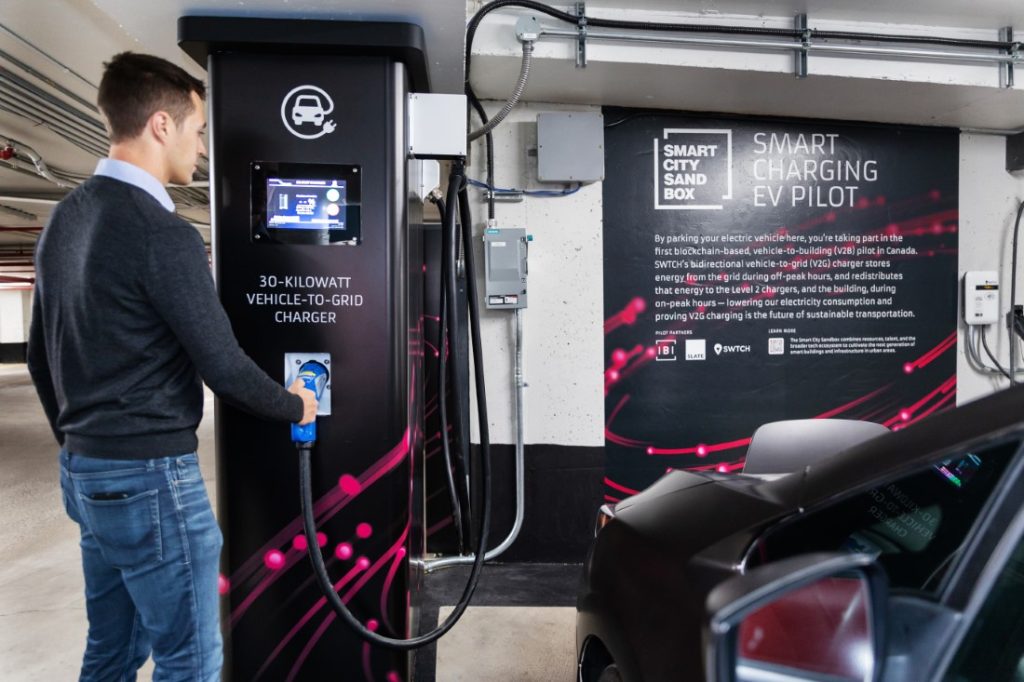
If we get all the details right, we could soon live in a world where just about every EV on the road is also an intelligent energy storage device. With opportunities for this to benefit private homeowners, multifamily tenants, property owners, utilities, and governments all, there’s a lot to be excited about.
As we continue to electrify everything, having a distributed network of battery storage as part of the fleet of cars we drive everyday will likely do a great deal for energy security, flexibility, and resilience for everyone.
Want to deploy EV charging solutions that can earn money through V2X participation?

